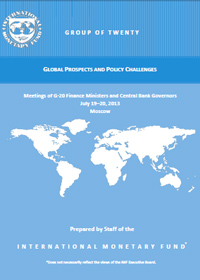Group of Twenty IMF Note-- Meetings of G-20 Finance Ministers and Central Bank Governors
IMF Note on Global Prospects and Policy Challenges
July 19–20, 2013, Moscow
About the Executive Summary
The Following executive summary is from a note by the Staff of the IMF prepared for the July 19–20, 2013 meetings of G-20 Finance Ministers and Central Bank Governors in Moscow.
Read the Full text ![]()
Executive Summary
The strength of the recovery disappointed once again and the outlook has weakened somewhat. Global growth improved from 2¼ percent (annual rate) in 2012Q4 to 2¾ percent in 2013Q1, but this was weakerthan- projected in the April WEO. The July WEO outlook is for lower growth in both 2013 and 2014, reflecting inter alia a (once again) delayed recovery in the euro area, as well as weaker growth in emerging economies.
Market volatility has been higher and financial conditions have tightened.Higher volatility following a strong market rally may stem from several possible sources, including some asset re-pricing following strong gains, uncertainty about tapering of U.S monetary stimulus; and market reassessment of emerging economy fundamentals. After a bout of disappointing data on emerging markets activity and following Fed’s signals that quantitative easing could be tapered earlier than expected, volatility and bonds yields have increased; and emerging market equities and currencies have fallen sharply, alongside capital outflows and liquidity pressures. Emerging economies with poor fundamentals and strong previous capital inflows have been hardest hit. In advanced economies, longer-term interest rates and financial volatility have increased and sovereign spreads in the euro area periphery have been widening, following a period of continued declines.
While tail risks have abated, important downside risks prevail. Although it is too soon to tell, the current market turbulence could continue and deepen. Growth could be lower than projected due to a protracted period of stagnation in the euro area, and risks of a longer slowdown in emerging markets have increased. Additionally, financial stability risks are a growing concern in both advanced and emerging economies. The eventual exit from low rates and unconventional monetary policy in advanced economies could pose challenges for emerging economies, especially if it proceeds too fast or is not well communicated.
Progress on the policy front is crucial to achieve a stronger and lasting recovery, while safeguarding financial stability. Specifically:
- Advanced economies should pursue a policy mix that is more supportive of near-term growth than in the
recent past, differentiated according to fiscal space, and anchored by a credible and concrete roadmap to
achieve fiscal sustainability. Monetary policy should continue to play its supportive role, given low
inflation and economic slack. Fiscal adjustment should proceed gradually, anchored by credible and
detailed medium-term plans with emphasis on “growth-friendly” adjustment. Financial sector reforms are
imperative, notably in Europe, where further progress in restructuring, resolving, and recapitalizing banks
and completing the banking union is critical to allow a revival of credit to the real economy.
- Emerging economies now need to navigate carefully through more turbulent waters. Monetary easing can
alleviate liquidity pressures and downside risks to growth but capital outflows may complicate actions.
Policymakers should be ready to address possible financial stability risks where high credit growth has
been prolonged, by strengthening oversight and macro-prudential policies. Risk of lower potential
suggests less room for fiscal accommodation and policymakers should focus on rebuilding fiscal buffers,
while addressing structural obstacles to continued high potential growth.
- Reducing global imbalances while supporting growth will require surplus economies to increase internal demand on a sustained basis and deficit economies to raise external competitiveness. Without policy progress on this front, the risks are that either global imbalances could widen again as output gaps in advanced economies are closed or global growth would remain sluggish.

